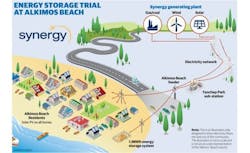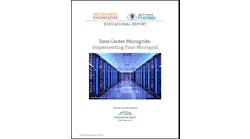Australia’s budding – and potentially massive – microgrid market is the focus of a major new deal between two industry powerhouses this week: property and infrastructure group Lendlease Services and leading solar and battery storage engineering company Energy Made Clean, a fully owned subsidiary of ASX-listed Carnegie Clean Energy.
Carnegie – formerly known as Carnegie Wave Energy – said on Monday that EMC had signed a Joint Venture Agreement with Lendlease Services, part of the broader Lendlease Group, to identify, pursue, bid for, secure and deliver EPC contracts for solar and/or battery energy storage systems (BESS) around Australia.
The initial three-year deal signals the major shift already taking place in Australia’s energy market dynamic and structure, as cheap, clean, reliable and locally generated energy becomes just one more part of the “sustainable living” package expected of new property developments.
Both companies already have considerable skin in the microgrid game, including together, on the community-level battery storage pilot kicked off last year in the northern suburbs of Perth – a sustainable community development at Alkimos Beach that combines 1.1MWh of lithium-ion battery storage with more than 100 rooftop solar homes, and is testing different electricity tariff options and retail models.
The new JV will work to the two companies’ strengths – including Lendlease’s national footprint across Australia, as well as its experience in the construction and maintenance of power distribution and generation assets.
EMC, which was fully acquired by Carnegie in October, has rapidly become one of Australia’s biggest names in renewable microgrid design and development, having built itself up from an innovative start up to delivering major contracts to local utilities (it is also working with WA’s Synergy for the Alkimos project).
As EMC’s managing director, John Davidson observed in an interview with RenewEconomy on Monday, the company’s journey from small and private, to double the size and listed (via Carnegie), and then partnered with one of the world’s largest property management groups, all in the space of just three months, mirrors the speed at which the market is growing.
“Our customers over the last 18 months have been the defense department, power utilities, water utilities; and the speed at which we have had to move has been frightening. And that’s not going to let up,” Davidson said over the phone from Perth.
…the speed at which we have had to move has been frightening — John Davidson, EMC
“We’ve been really successful in this fast growth industry by creating …strategic alliances, and the successful completion of Alkimos brought us back into view with Lendlease, which fit us perfectly, because they’re very active in remote areas.
“We can now start coming over towards the eastern seaboard (of Australia) and have a presence there, with Lendlease,” he added, noting the two companies had already written a number of joint proposals.
“There is substantial opportunity inside Australia and we now have the tools to really gear up for it,” Davidson said.
Just last week, Carnegie announced a separate joint venture, in which EMC would collaborate with Japanese company Sumitomo Electric Industries to develop and demonstrate a commercial-scale solar and battery storage plant in Australia, using Sumitomo’s vanadium redox flow (VRF) battery technology.
Carnegie Clean Energy managing director, Michael Ottaviano, said the new deal with Lendlease would give both companies access to a broader range of “blue-chip” microgrid clients, including network providers, utilities, large-scale residential developments and defense.
In particular, he said it would significantly boost the already rapid growth of the EMC business, which turned over $16 million in revenues in the 2016 financial year.
“The size of the target market within Australia, across off-grid; fringe-of-grid; commercial and industrial is estimated to be in excess of $1.6 billion over the next five years, and $5 billion over the next 10 years, as the costs of solar and BESS continue to fall and renewable energy penetration continues to grow.
“This partnership will enable us to seize this significant opportunity and cement our position as market leader in this space,” Dr Ottaviano said.
This article was originally published by Australia-based One Step Off the Grid and is reposted here with permission. Author Sophie Vorrath is deputy editor of One Step Off the Grid.
Track news about the microgrid market on Twitter @MicrogridNews.







